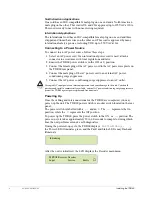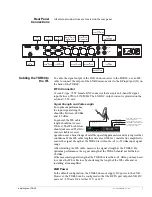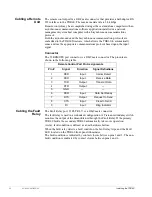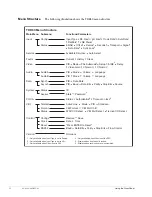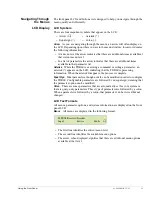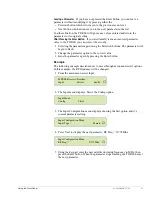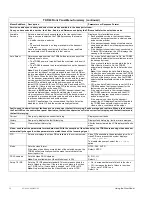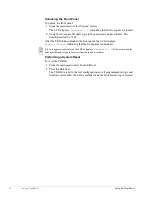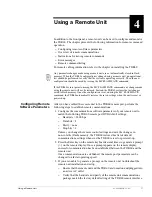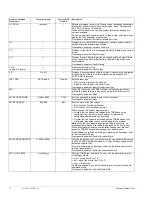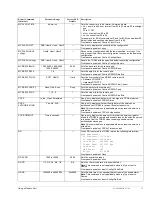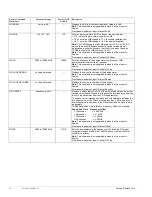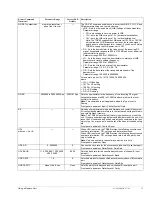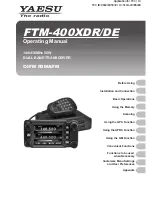
20
01-0868-401B 12/02
Using the Front Panel
Service: enables you to query and select the services available in the transport stream.
Once you have selected a service, the Video, Audio, and Data menus display the PIDs available for the selected service.
Available
Services
Selects a service from those available in the transport stream.
Once a service is selected, the TDR60 processes that service
until:
■
Another service is selected
or
■
The selected service is no longer available in the transport
stream
Once a service has been selected, the Video, Audio, and Data
menus display the PIDs available in that service.
Displays a list of available services.
■
Each available service in the transport stream
consists of a program number, a service name,
and a service provider.
■
If the transport stream does not contain service
names and providers, only the program numbers
are displayed.
■
If the transport stream input is not connected, or
if it lacks PSI information, the LCD displays the
message:
No services available
.
Auto Select
Determines which service the TDR60 will select when any of the
following events occur:
■
The TDR60 power is turned off and then restored, or the unit it
reset
■
The TDR60 loses and then re-establishes lock on the transport
stream
Note
: Since the typical
SCPC
transmission consists of a single
service that includes of a single video/audio pair, the Auto Select
feature was added to simplify the configuration process for typical
SCPC users. When the Auto Select feature is enabled, or set to
On, the decoder automatically selects the service with the lowest
service number first, then selects the video component with the
lowest PID, and finally selects the audio components with the
lowest PIDS for audio A/B (one PID for audio A and another PID
for audio B). If there is only one audio PID in the service, then both
Audio A and B will have the same PID.
However, in
MCPC
applications, the MPEG transport stream may
contain multiple services, each with multiple video, audio, and
other components. With Auto Select set to Off, the decoder can be
configured to process a particular service, and within that service,
to process selected video and audio services.
For MCPC applications, it is recommended that Auto Select be
disabled, or set to Off, and the service manually selected.
■
On – when Auto Select is set to On, the TDR60
automatically selects the first available service in
the transport stream.
If you manually select a service while the Auto
Select function is set to On, the TDR60
automatically changes the Auto Select function
to Off.
Note
: If you change the Auto Select function to
On after you have selected a service, the TDR60
will continue to process the service you selected
until one of the events occurs, then the TDR60
selects the
first
available service in the transport
stream.
■
Off – when Auto Select function is set to Off, the
TDR60 searches the transport stream for the
last service you manually selected.
If the service is found in the transport stream,
the TDR60 selects the service, and the LCD
displays the program number, service name,
and service provider.
If the service is not found in the transport
stream, the LCD displays Service Not Available,
the TDR60 does not select a service, and no
video, audio, or user data will be output.
Faults: used to view all current faults and to view and clear the fault history log. Faults are reported real-time. When a fault occurs,
the Fault LED on the control front panel illuminates, the fault descriptor is sent to the current fault display, and the fault is stored in
the fault history log
.
Current
Query-only; displays the current faults log
Displays current faults
History
Query-only; displays the fault history log
Displays fault history log; faults are time stamped
Clear
Clears the fault history log
After faults are cleared, the LCD displays the Faults
menu
Video: used to set the parameters for standard video. With the exception of the video delay, the TDR60 auto-sensing video decoder
automatically changes the video parameters to match those of the incoming signal.
PID
Selects or displays the video PIDs available in the current service.
Video PIDs available in the selected service. If no
video PIDs are present, the system displays:
no video present
.
To disable video output, select the
no video
option.
Mode
Sets the video format.
If the video mode does not match that of the selected service, the
TDR60 will automatically switch the mode to match that of the
incoming service.
NTSC, PAL, AUTO
Default: NTSC
PAL Submode
Sets the video PAL Submode.
Note
: Only available when Video>Mode is set to PAL.
B, D, G, H, I
Default: I
Setup 7.5 IRE
Sets the 7.5 IRE pedestal-standard. This command controls the
level of black in the video. If there is too much black in the video,
set 7.5 IRE to On; if more black is needed, set 7.5 IRE to Off.
Note
: Only available when the Video>Mode is set to NTSC.
■
On – decreases the level of black in the video
■
Off – increases the level of black in the video
■
Auto – sets 7.5 IRE to on
Default: On
TDR60 Front Panel Menu Summary (continued)
Menu>SubMenu
Description
Parameters or Response Format
Содержание TDR60
Страница 10: ...viii 01 0868 401B 12 02 Preface...
Страница 14: ...4 01 0868 401B 12 02 TDR60 Overview...
Страница 48: ...38 01 0868 401B 12 02 Using a Remote Unit...
Страница 66: ...56 01 0868 401B 12 02 Technical Specifications...
Страница 74: ...64 01 0868 401B 12 02 QPSK Demodulator Application Notes...

